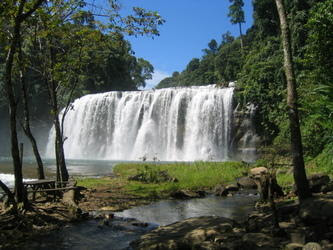Activate the claim using Post Claim
Blogger Posting Instructions
In another web browser window, log in to your Blogger account
On the Blogger Dashboard, click on your blog name
Click "Create" to create a new post
Copy the code below, then paste it into the main text box of your new post with any Title :
Technorati Profile
Sunday, September 30, 2007
Technorati
Posted by
Rommel
at
3:20:00 AM
0
comments
![]()
Labels: internet
Technorati
Activate the claim using Post Claim
Blogger Posting Instructions
In another web browser window, log in to your Blogger account
On the Blogger Dashboard, click on your blog name
Click "Create" to create a new post
Copy the code below, then paste it into the main text box of your new post with any Title
Technorati Profile
Posted by
Rommel
at
3:14:00 AM
0
comments
![]()
Labels: internet
Monday, September 24, 2007
Bawud sa Bislig Bay
Usahay ang bawud maputiay,
malipayun,
yagligidligid sa dagat;
duwum, adlaw.
Pero usahay ang bawud maitumay,
yadaman,
yagligidligid sa dagat na yaglagutay.
Posted by
Rommel
at
12:18:00 AM
0
comments
![]()
Ang Tulay
Ang karaan na tulay maraatay da ang bayho,
Agbawukun naan ang kanaan likud
Para muagi kita.
Sakitan yaan ug magtiyahu
Pero diri nato madungug.
Kapuok ang sa kanak bayhu
Kay ang kabug-at na ipaga-baba naan
Sa yang agi na mga utaw ug sakyanan
Ingpahuwug ng mga kahuy ang kaniran dahon sa tubig;
Ang langit yagyangu kaniran.
Ang mga dahon yaglutaw na amura mga mga barko
Ang mga isu na gagmay yaghampang sa kilid ng tulay.
Posted by
Rommel
at
12:14:00 AM
0
comments
![]()
Sunday, September 23, 2007
Katanduan
a poor man in Bislig ,
skin browned under the sun,
tired necks and limbs,
dampened backshardened feet.
rustle of caramcam leaves and nipa palms,
crossing the hanging makeshift bridge
over the echoing muddy brooks.
Posted by
Rommel
at
1:45:00 AM
0
comments
![]()
Labels: bislig
Houses on Stilts along the Bislig River
Posted by
Rommel
at
1:39:00 AM
0
comments
![]()
Labels: bislig
Hangin sa kilid ng dagat
Lubas ako amura nga dahon
ug mabati ko ang hangin sa kanak abaga.
Ang mga kahoy yanghikuwo,
Pagkuha ko ng suga sa kanak alima.
Ang hangin inglupog ang bawud,
Yakalukotlukot ng maputi na bura
Posted by
Rommel
at
1:30:00 AM
0
comments
![]()
Bislig Hymn
Buhi ang kahusay mo, sa mga panan-aw ko
Suba hasta kakahuyan, sang mga kadayahan
Sa paghago malugot na ang damgo maabot
Depensahan ang katungod indugan ang tinood.
Tipigi ang kadatu mo sang kadaywan mo
Na diri usikan nang bisan haw sino
Kabahin ng pangandoy ko dayon ang pag uswag mo
O lungsod ng Bislig na ihigugma ko
O lungsod ng Bislig na ihigugma ko.
O Bislig na ihigugma ko.
Posted by
Rommel
at
12:36:00 AM
0
comments
![]()
Thursday, September 20, 2007
Poblacion, Bislig
murmuring waves bouncing in the seawall of boulevard
amidst the choco-colored beach of bislig.
flapping of nipa leaves
in the murky creeks of Catanduan.
laughters of dirty and brown haired children
of Baybay II.
rude punky teenagers
gallavanting in the highway.
echoes of voices in the far,
What could there be in silence?
Posted by
Rommel
at
7:08:00 PM
0
comments
![]()
Labels: bislig
Saturday, September 15, 2007
Tuesday, September 11, 2007
Monday, September 10, 2007
My Home, My City, My Bislig
the city, verdant trees lies on the western hills,
the bislig bridge reaches the clear river’s eastern bank.
In the wind and sea, the city, my dreams are now dispersed,
Alone at the end of the sky, I weep for what is lost.
I nurse myself alone, outwith the city,
at times I gaze afar,
I cannot bear our condition,
which daily grows more desolate
Posted by
Rommel
at
7:09:00 PM
0
comments
![]()
Sunday, September 9, 2007
Bislig: its Origin
However historical records state that the name has been variously spelled by the Spanish chroniclers. Conquistador Miguel de Loarca, in his extreme exploratory survey trip of the archipelago, first mentioned and spelled it Beslin in his historical accounts “Relacion de los Yslas Filipinas” in 1582, as well as in the Confirmaciones de Encomienda (1616- 1700) which Bislig was under the encomienda of Alferez Juan delas Marianas in 1619. In the “Historia general de los religiosos descalzos del orden de San Agustin” of Fray Andres de San Nicolas in 1664 spelled it Bislin and also in the “Historia general… del Orden de San Agustin” of Fray Luis de Jesus in 1681. A Franciscan writer, Fray Juan de San Francisco de San Antonio spelled it Baslig in his “Cronicas” in 1738. Other Spanish chroniclers spelled it Bislic and Bisliq. [Blair & Robertsons: Phil. Island 1493-1898]
In the first detailed map of the Philippines in 1749, published in “Historia de la Provincia de Philipinas” by a Jesuit, Father Pedro Murillo Velarde spelled it Bislig, as did in the “Historia General …” of Fray Pedro San Francisco de Assis in 1768 and in the “Mapa dela Provincia de Caraga” by Francisco Alegre in 1751. A complete statistical data of District of Caraga compiled in 1750 spelled as Bislig, and also in the document titled “Provincia de San Nicolas de Tolentino de Agustinos descalzos dela Congregacion de España y Indias” in 1879.
From the time on, it is known and spelled as Bislig, hence, Bislig become the standard spelling up to the present that this place has metamorphose to become one of the charter cities of the Philippines – Bislig City .
Posted by
Rommel
at
12:43:00 AM
0
comments
![]()

























